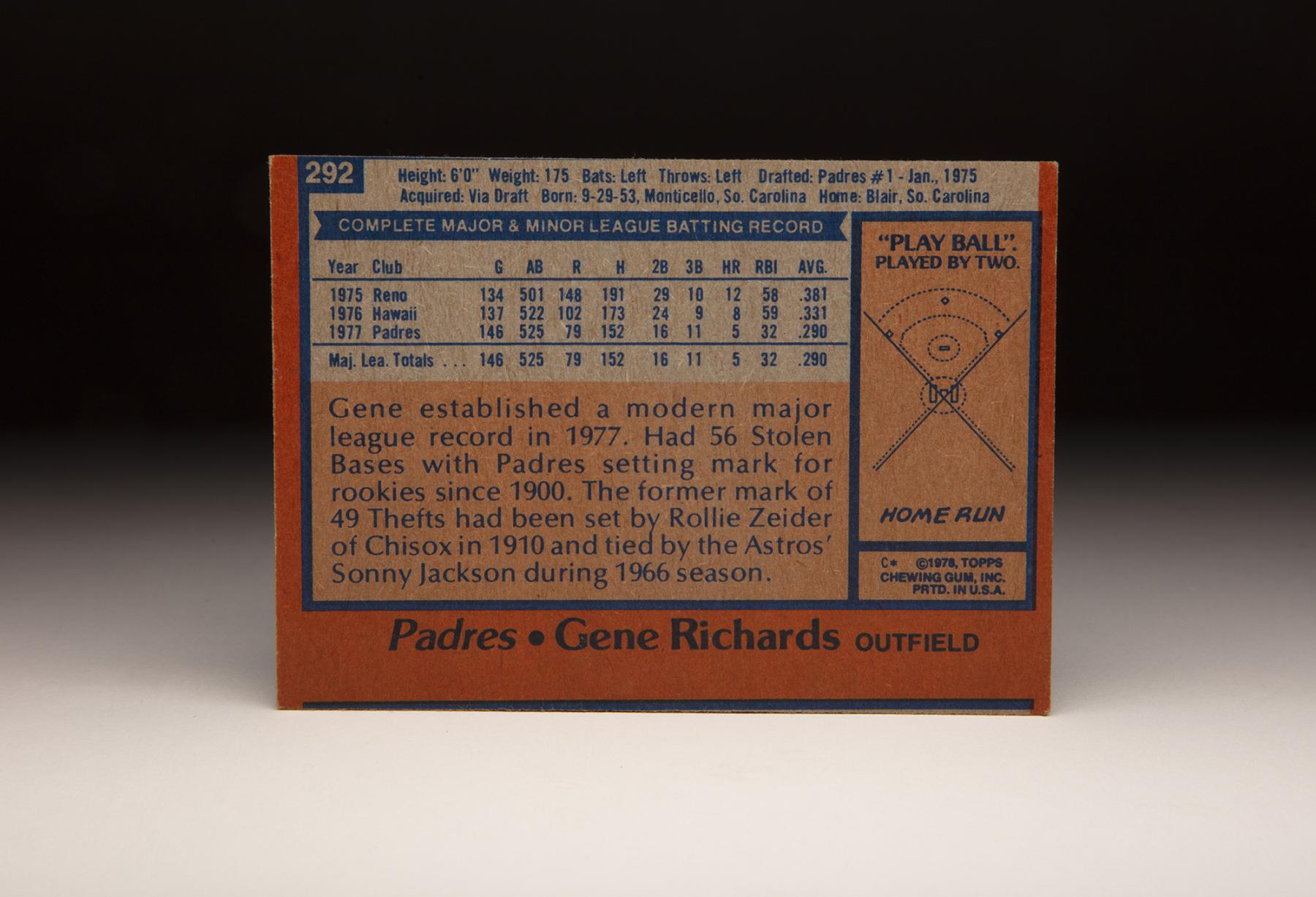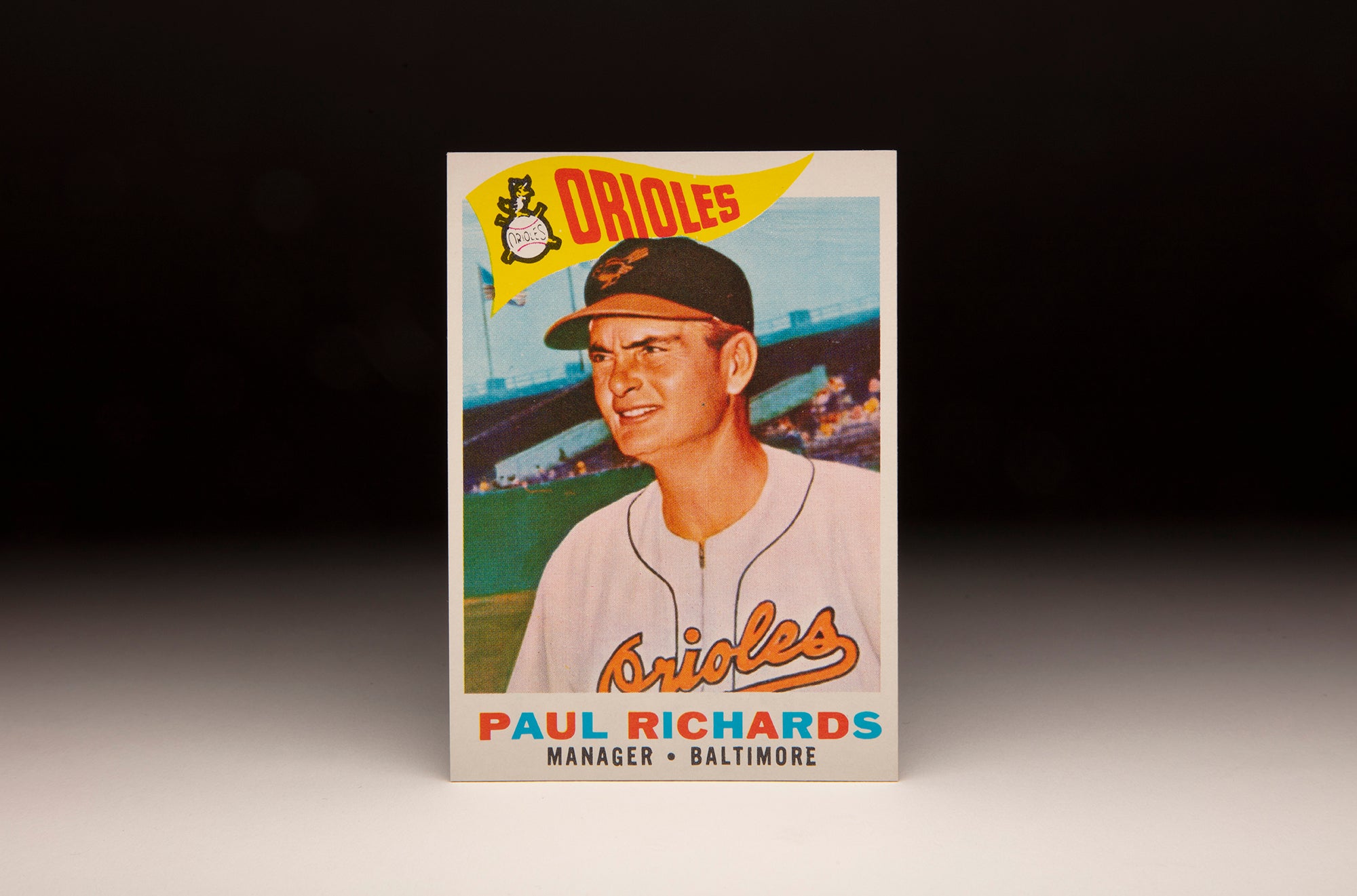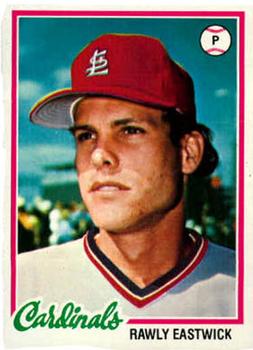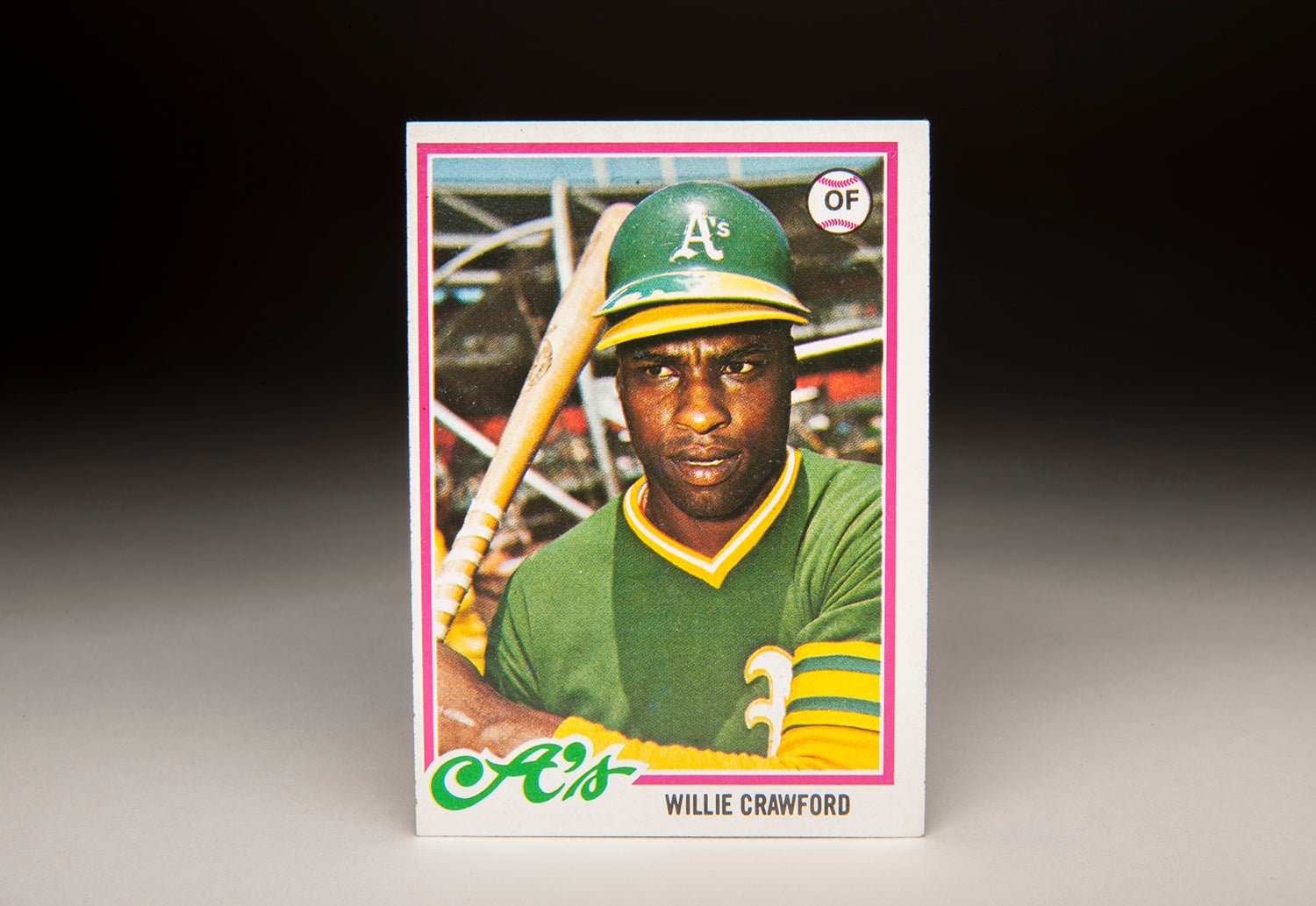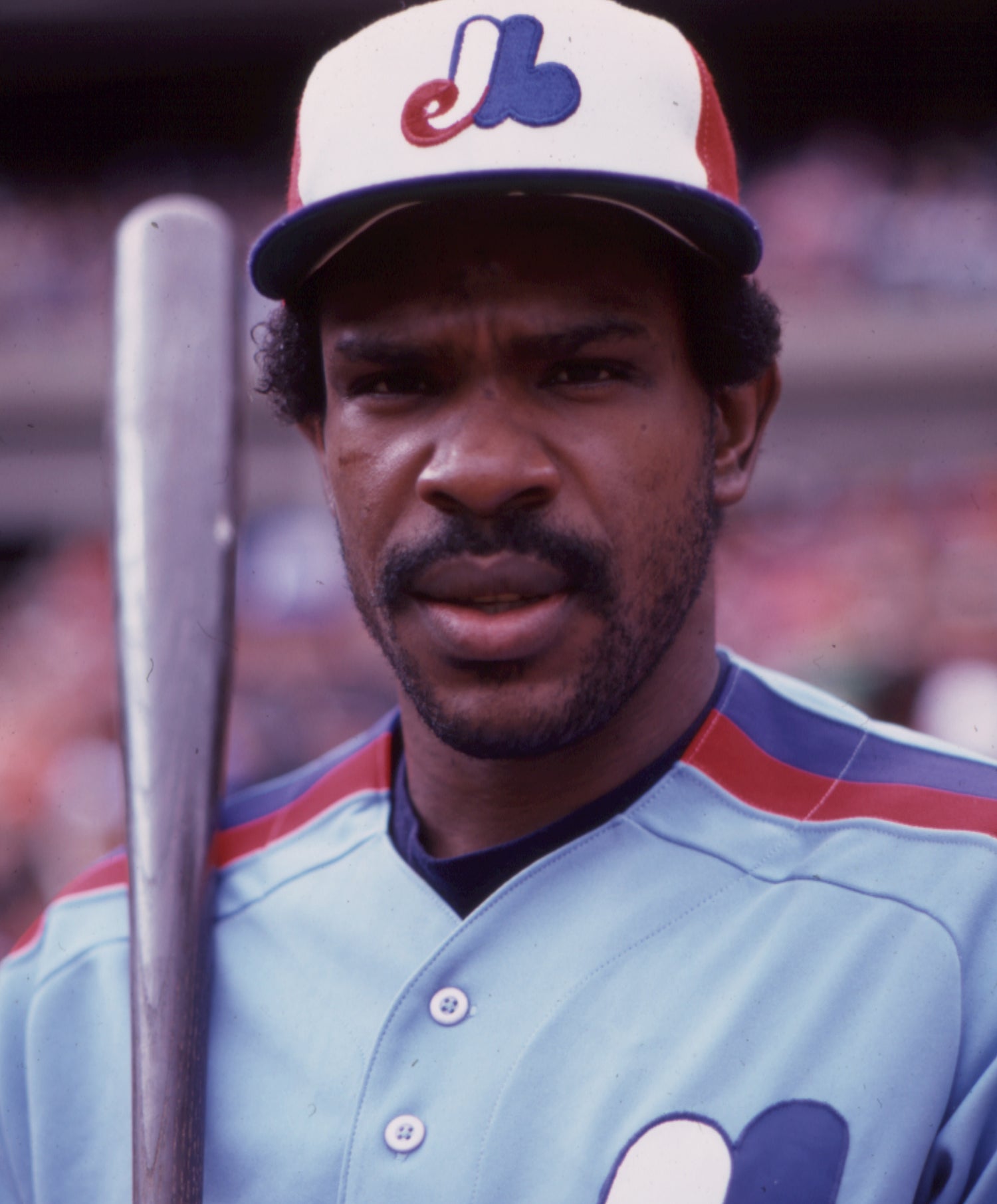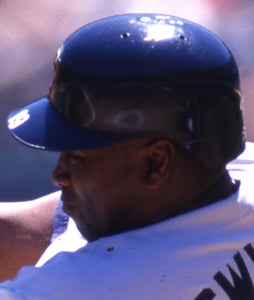- Home
- Our Stories
- #CardCorner: 1978 Topps Gene Richards
#CardCorner: 1978 Topps Gene Richards
Gene Richards’ was once the top first-year base stealer in modern big league history, a record he no longer owns.
But Richards’ most lasting distinction may be his for decades – because it’s hard to imagine any of today’s hitters choking up on the bat like the former Padres and Giants outfielder.
Hall of Fame Membership
There is no simpler, and more essential, way to demonstrate your support than to sign on as a Museum Member.
Official Hall of Fame Apparel
Proceeds from online store purchases help support our mission to preserve baseball history. Thank you!
Richards appeared on several Topps cards with his unusual left-handed batting grip that seemed to place his top hand nearly halfway up the barrel. While that tactic cost Richards power, it enhanced his ability to hit the ball to the open spot.
And with his speed, all Richards needed was a little grass under the ball.
Born Sept. 29, 1953, in Monticello, S.C., and enrolled at South Carolina State after graduating from high school. Richards was primarily a pitcher for SCS. But the university dropped baseball as an intercollegiate sport in 1974, leaving Richards with no games to play following a 1974 summer season with Harrisonburg in the Shenendoah Valley League.
Finally eligible for the MLB Draft in January of 1975, Richards was the first player selected – going to the San Diego Padres, who turned Richards into an outfielder.
“Deep down I thought I would be picked,” Richards told the Associated Press on the day of the draft. “But I didn’t expect to be chosen first.”
The Padres sent Richards to Class A Reno of the California League in 1975, and Richards hit .381 with 191 hits and 116 walks, totaling an other-worldly .499 on-base percentage to go with 148 runs scored and 85 steals. He struggled defensively, but Richards’ speed and plate discipline made him an instant prospect.
“His running speed is his strongest asset,” Bob Fontaine Sr., the Padres scouting director, told the Associated Press. “He’s a contact hitter. In style, he’s like any player who makes contact with the ball almost all the time and uses his legs to get on base. He has that little bit of daring in him that makes for a good baserunner.”
After spending Spring Training of 1976 with the Padres, Richards was promoted to Triple-A Hawaii, where he hit .331 with a .435 on-base percentage, 91 walks and 102 runs scored. Then in 1977, Richards was named the Padres starting left fielder. After a slow start, Richards heated up with the weather and hit safely in 20 of his last 22 games to finish the season with a .290 batting average and a .363 on-base percentage.
Richards’ 56 steals were the most of any modern era (post 1900) player who played the first game of his big league career in what would qualify as his rookie season.
“He should be in St. Louis,” Reds manager Sparky Anderson told the Associated Press. “The way he hits the ball, he would hit .320 on that hard Astroturf easy.”
Richards finished third in the National League Rookie of the Year voting behind Andre Dawson and Steve Henderson, then avoided any sophomore jinx by hitting .308 in 1978 with 64 walks, 37 steals, 26 doubles and 90 runs scored as the Padres won 84 games to record their first winning season in franchise history.
Richards slumped in 1979 – hitting .279 with 24 steals – as the Padres moved him from left to center field. But he returned to left field in 1980 and produced his best season, hitting .301 with 193 hits, 26 doubles, 91 runs scored and 61 stolen bases.
The Padres totaled 239 steals that year and Richards joined Ozzie Smith (57 steals) and Jerry Mumphrey (52) as the first NL trio with 50-plus steals on a modern era NL team.
But Richards began to chafe in San Diego, feeling he was unfairly targeted by critics because he was quiet and reserved.
“I want to be judged solely by my performance on the field,” Richards told the Los Angeles Times late in the 1980 season when he was opening campaigning to be traded. “And not for the way I smile.”
But the Padres held onto Richards and were rewarded in 1981 when he led MLB with 12 triples in 104 games in the strike-shortened season, hitting .288 while stealing 20 bases.
But Richards would never again approach his stolen base total from 1980, stealing just 30 bases in 132 games in 1982. By 1983, Richards was eased into a bench role by manager Dick Williams and appeared in just 95 games, hitting .275.
The Padres tried to deal Richards throughout the 1983 season, but found no takers.
He became a free agent following the season and found few offers, finally signing a one-year deal with the Giants less than a week before the 1984 season opener.
After hitting .252 with only four extra base hits in 87 games for San Francisco, Richards’ playing career ended. He finished with a .290 batting average over 1,026 games with a .357 on-base percentage and 247 stolen bases. He is also the only Padres player other than Hall of Famer Tony Gwynn to wear the No. 19 in a game, having worn that jersey in 1978.
Following his career, Richards became a respected instructor with the Angels, Dodgers and Mets well into the 2000s, passing his base running and batting knowledge down to a new generation of players.
Apparently, however, Richards was unable to find any disciples who would embrace the small-ball game that served him so well for eight big league seasons.
Craig Muder is the director of communications for the National Baseball Hall of Fame and Museum


